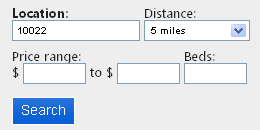Interestingly, the last quarter saw striking accord amongst the firms (including Halstead/Brown Harris Stevens, Corcoran, Stribling, and Prudential Douglas Elliman).
Their conclusion: the Manhattan market is an island of stability in the midst of national and international turmoil, seemingly exempt from the eye-popping year-over-year losses experienced in the rest of the nation.
From U.S. coast to coast, the sad drumbeat of bank foreclosures on homes (and their evil twin — local sales price depression) is still a constant. But foreclosures are extremely rare in New York City. The heartbreaking percussion is quiescent. Here’s why:
Foreign Buyers
Financial and political stability in the US is still a given; so buying property in the U.S. is a financial flight to safety. New York City has added cachet as an international city that survived the public challenge of 9/11. It still stands as the financial capital of the world. It has become an “it” city – which means that owning in Manhattan is another requisite to
being part of the club of international elite.
Add to that the fact that the dollar is weak, making everything U.S. more affordable. That is certainly so in comparison to other international cities. To wit: the average price per
square foot in NYC is $1,068 compared to $1,395 in Madrid, Spain, $1,590 in Londan, UK, and $3,287 in Paris, France.
Reluctant Sellers
“The Class of 2007”: Homeowners who once were buyers of new properties during the boom are facing the harsh reality that those sales figures they watched march ever upwards for a full decade, have made a strong retreat.
And unless there are pressing circumstances, the “Class of 2007” would prefer to find a way to hold onto their properties until they can sell for as much or at least a little more than they paid. Said one seller of an Upper East Side new condominium who has decided to stay put after marketing his one bedroom for nearly ten months, “If I can’t get my price, I do not want to sell.”
A Decline in New Construction
The number of permits filed with the City of New York for new construction presents a simple fact. In 2008, at the end of the big boom, there were 9,700 filings to build new units. One year later, post Bear Stearns’, and Lehman’s collapse, there were 1,363.
And one year later, filings were a mere 704! “The numbers [last year] were abysmal. These low levels have not been seen since the early 1990’s,” according to Gregory Heym, executive vice president, and chief economist for sister firms Brown, Harris Stevens and
Halstead Property, LLC.
There was a rebound in the past nine months, according to Heym, with filings for 1,736 new units. But there is a logical and significant lag time between the issuing of a permit and the marketing and sale of a property of approximately two years. That lag time is making itself felt now by a lack of new property inventory. Most educated prognosticators believe the result is that sale prices in Manhattan are destined to rise, at least when it comes to new properties.
Rising Rental Prices
In Q3 2011, the price of two bedroom rental apartments rose 16% in non-doorman, and 11% in doorman buildings year over year. One bedroom rental prices were up 9.5% year over year, and studio rentals increased 5.8%.
Concessions of a free month, or no move-in fee, etc., with very few exceptions, have become a thing of the past. Renters who signed two-year leases in November/December, 2009 are finding a completely different market from the 2009 vacancy rate of 32 percent. Today the vacancy rate is, and has been for most of the year, below one percent. The rising Manhattan rents have been effectively driving price sensitive sales and rentals into
Brooklyn and Queens. Manhattan landlords are happy. And for some stalwart
New Yorkers it is now less expensive to own than to rent.
Absorption
And then there is the absorption rate – and it does not include the intense fascination most New Yorker’s have with their real estate whether rented or owned (have you ever noticed how many bits of conversation you overhear on the street that are strictly about people’s apartments? Check it out, it is substantial!)
In this case it is the number of months it will take to sell the inventory of apartments in the current sales marketplace. If there is six to nine months of sale inventory, the absorption rate is considered neutral. The current absorption rate is 7.5 months, or equilibrium for New York City as a whole.
Bottom line: In a chaotic world, New York City real estate is a rare entity: it is a stable investment.



